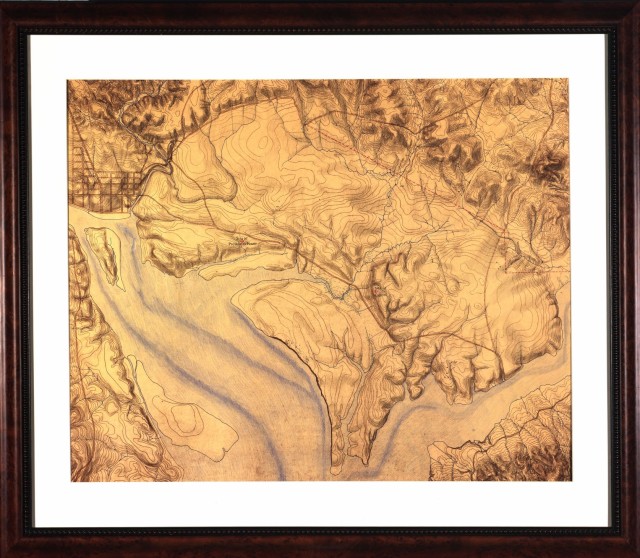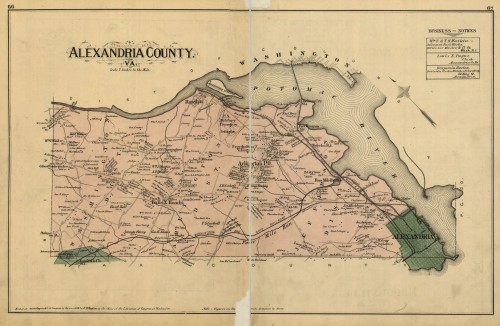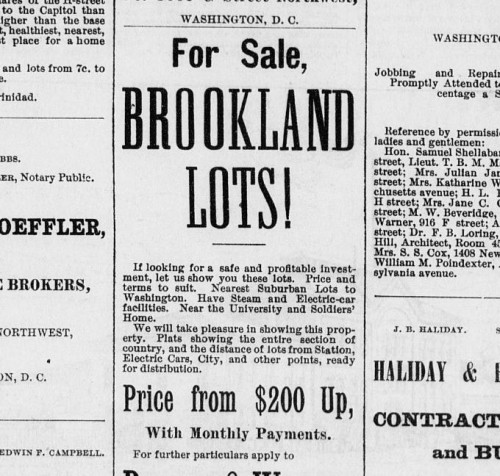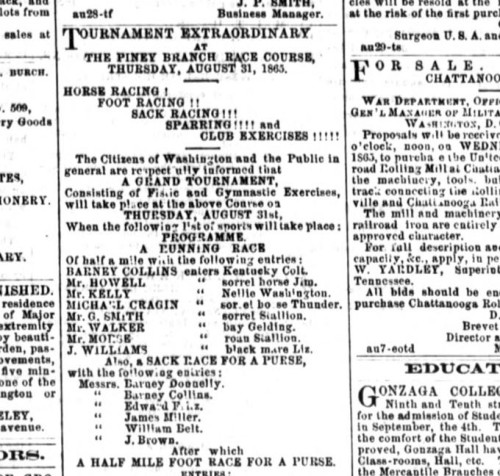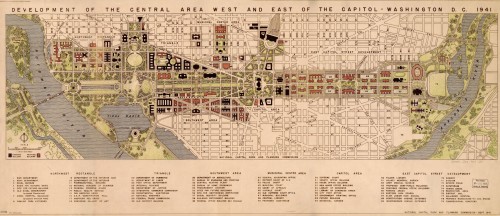click map to enlarge. Source: Library of Congress
Map of the Week is written by David A., a systems librarian and map geek living in NoMa. David previously wrote about a Birdseye view of the National Capital from 1892.
This 1791 topographical map gives a very raw look at the DC landscape before the city had streets. You can see that topography very much defined the original city limits. Boundary Street, today’s Florida Avenue, followed the bottom of the hill that still marks the border between the U St area and Columbia Heights and Adams Morgan.
If you look closely, unmarked buildings appear throughout the city. Another interesting feature is the broad creek running just south of the White House. With the exception of Rock Creek, all of the creeks in the original city limits would be filled in or covered over. Georgetown’s street grid looks very similar to today’s grid. An act of the Maryland Legislature set in motion the building of Georgetown. Surveying was completed in 1752, and by the time of the publishing of this map it had grown into a thriving port of trade.
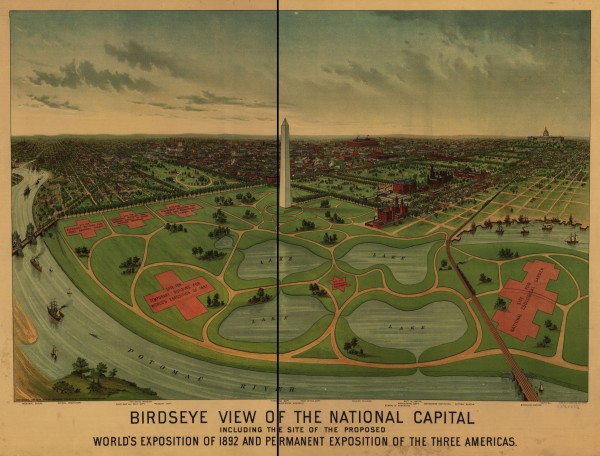
click map to enlarge. Source: Library of Congress
Map of the Week is written by David A., a systems librarian and map geek living in NoMa. David previously wrote about the Potomac River from 1861.
Title: Birdseye view of the National Capital, including the site of the proposed World’s Exposition of 1892 and Permanent Exposition of the Three Americas
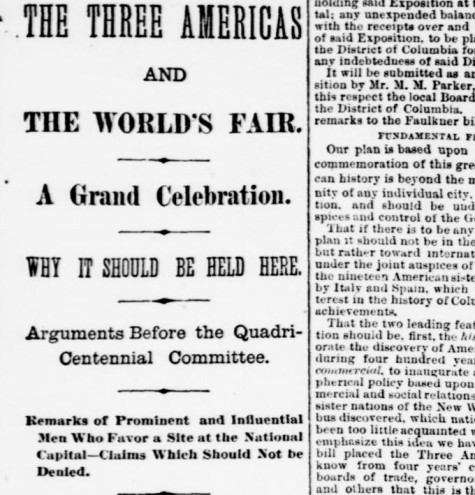
I really like this 1888 bird’s-eye view of the National Mall and surrounding area. This map laid out plans for a permanent exposition and a world’s fair to celebrate the centennial of the U.S. Constitution and the 400th anniversary of Christopher Columbus’ arrival. Some interesting details include old-timey ships on the SW Waterfront, a presumably never-built tower bridge across the Potomac, a Star of David-shaped monument to Columbus and a strangely empty street grid in SW. Proponents made their case for a Washington-hosted world’s fair in a January 18, 1890 issue of the Evening Star newspaper. They were unsuccessful. Chicago ended up hosting a quadricentennial world’s fair in 1893 to great acclaim.
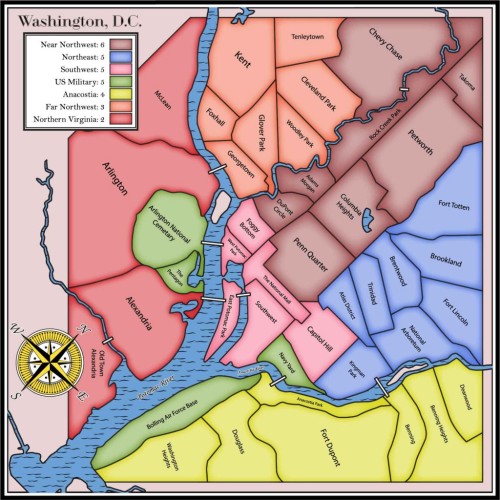
Map via Havoc Boards Click to enlarge
Thanks to a reader for sending a link to the Kickstarter page for Havoc Boards:
“War gaming on 15 custom maps. Available in classic style and engraved wood, Havoc Boards let you conquer the world one piece at a time.”
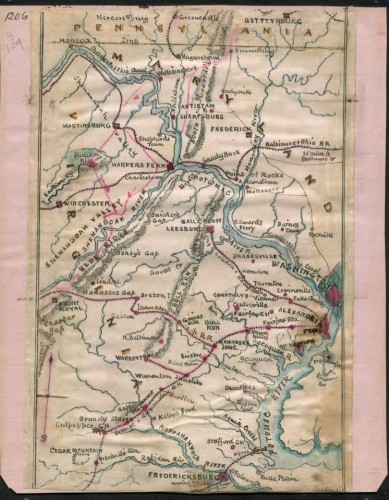
click map to enlarge. Source: Library of Congress
Map of the Week is written by David A., a systems librarian and map geek living in NoMa. David previously wrote about Alexandria County from 1879.
Title: Map of the Potomac River (1861)
This week’s hand-drawn map of the Potomac River and its tributaries comes from the Civil War era diary of Robert Knox Sneden, a map-maker for the Union Army. Railroad routes and stations feature prominently. The Library of Congress hosts 316 of Sneden’s maps on its website.
click map to enlarge. Source: Library of Congress
Map of the Week is written by David A., a systems librarian and map geek living in Mt. Pleasant. David previously wrote about Palisades of the Potomac from 1890.
This week’s 1879 map provides a view of Arlington and Alexandria when they were part of the federal district. If you look close, you can see that this map splits the former Alexandria County into three different smaller “districts”: the Washington District to the west, the Jefferson District to the east and the Arlington District in the middle.
Notable features include the names of many of the area’s landowners, the names of railroad stations, and the C&O Canal segment connecting Alexandria to the aquaduct bridge to Georgetown. The canal, also known as the Alexandria Canal, would be abandoned seven years after this map’s printing.
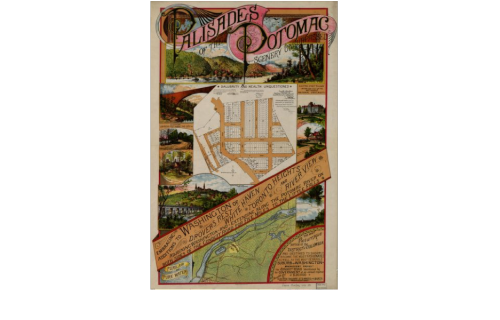
click map to enlarge. Source: Library of Congress
Map of the Week is written by David A., a systems librarian and map geek living in Mt. Pleasant. David previously wrote about a James E. Clements’ map of Washington City from 1891.
This eye-catching 1890 poster advertised a brand new neighborhood just north of the Georgetown Reservoir in the Palisades, a section of the district that extends from west of Georgetown to the Maryland border. The Palisades grew along the the Washington and Great Falls Electric Railway, a streetcar line that ran from Georgetown to Cabin John.
The accompanying images are probably more interesting than the map in the center. MacArthur Boulevard runs over the Cabin John Bridge, which still stands today.
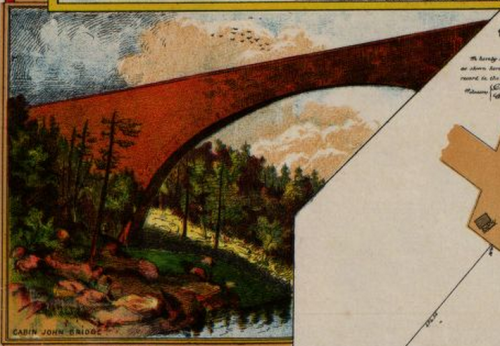
Continues after the jump. Read More
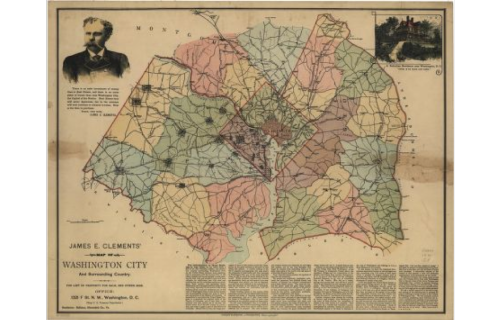
click map to enlarge. Source: Library of Congress
Map of the Week is written by David A., a systems librarian and map geek living in Mt. Pleasant. David previously wrote about a Topographical sketch of the environs of DC from 1867
Title: James E. Clements’ map of Washington City and surrounding country
James E. Clements’ 1891 map is all about selling the capital region to prospective buyers of real estate. The copy boasts of the region:
The people are neighborly, hospitable, cultivated and generous, and political liberty and freedom of opinions are enjoyed untrammeled and to their fullest extent. The taxes are low, and the public roads are good, being rapidly converted into solid stone and gravel highways. In fact, everything here is combined to make homes in this section comfortable, profitable, enlightened, and happy.
The mustachioed Clements is pictured at the top left of the map and sells the region thusly:
There is no safer investment of money than in Real Estate, and there is no surer place to invest that near Washington City, the Capital of the Nation. Real Estate here will never depreciate, but to the contrary will ever continue to enhance in value. Now is the time to purchase.
Yours, very truly,
James E. Clements
In 1891, lots in Brookland were priced starting at $200. That’s a little over $5,000 in today’s money.
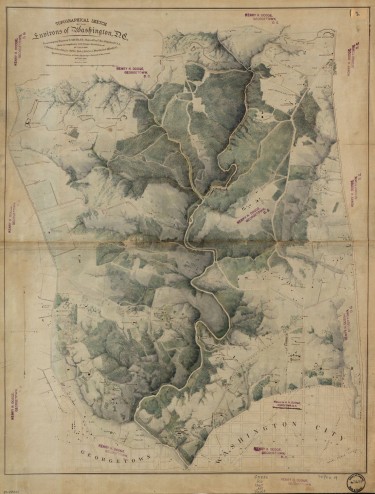
Click map to enlarge. Source: Library of Congress
Map of the Week is written by David A., a systems librarian and map geek living in Mt. Pleasant. David previously wrote about Washington, the beautiful capital of the nation – 1922.
Title: Topographical sketch of the environs of Washington, D.C. : (survey of locality for public park & site for a presidential mansion), 1867
This shaded relief map of present-day Rock Creek Park and surrounding lands comes from an 1867 survey ordered by the U.S. Senate in 1866. Michler’s map does a great job illustrating the rolling altitude of the northern part of the District. Aside from topographical features, the map includes some cadastral information (land holdings) and some road names.
Rock Creek Park did not come into being until 1890, but this map had a role in its beginnings. The U.S. Senate commissioned it out of dissatisfaction with the White House building and the desire for more park land. Rock Creek Park: An Administrative History, by Barry Mackintosh, tells the story:
On June 25, 1866, the United States Senate directed its Committee on Public Buildings and Grounds “to inquire whether a tract of land of not less than three hundred and fifty acres, adjoining, or very near this city, can be obtained for a park and site for a presidential mansion, which shall combine convenience of access, healthfulness, good water, and capability of adornment.” Sensing that it may have overly limited its options, the Senate passed another resolution five days later lowering the minimum size to 100 acres. Then realizing the need for professional landscape gardener or topographical engineer to examine the different tracts of land offered to the committee” and to report on their suitability for the desired purpose.
Like many of the other maps featured in this series, this map includes a race course. The Piney Branch Race Course sat not far from the present-day Rock Creek Park Tennis Center. T. Rohr’s Piney Branch Hotel served visitors to the track. An 1865 ad in the Daily National Republican newspaper boasted the following event at the race course:
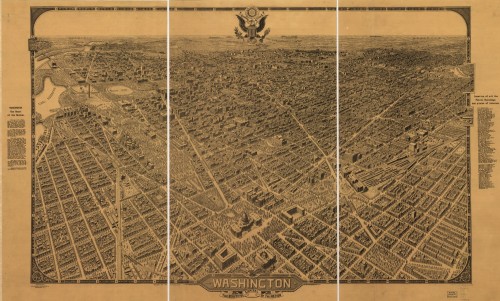
Click map to enlarge. Source: Library of Congress
Map of the Week is written by David A., a systems librarian and map geek living in Mt. Pleasant. David previously wrote about Development of the area west and east of the Capitol – 1941.
This bird’s eye view drawing of Washington, DC from 1922 was among the most detailed city drawings of its kind when it was created, according to the publisher’s hyperbolic caption:
“This Aero View of Washington is the most remarkable map picture that has ever been made. Remarkable for its great range of vision and the stupendous task in making such a drawing and the extreme accuracy in the architectural ‘lay-out’.”
Zoom in to see some of the really impressive details that took two years for the artist to draw. Many of the buildings have labels describing them. Two monolithic buildings housing the War Department and Navy Department occupied the land south of Constitution Avenue and east of the Lincoln Memorial. Another notable difference between this map and that of the present day is the large number of trees on the Mall and surrounding it. It’s hard to say whether these trees stood exactly where the artist put them or whether they were artistic flourishes to fill space. A few of the buildings around the Mall have also changed hands or disappeared since 1922 (Bureau of Fisheries, Center Market, Medical Museum). See if you can spot the Piggly Wiggly building in present-day NoMa.
Click map to enlarge. Source: Library of Congress
Map of the Week is written by David A., a systems librarian and map geek living in Mt. Pleasant. David previously wrote about Rand, McNally & Co.’s D.C. in 1903.
Title: Development of the central area west and east of the Capitol–Washington D.C. 1941
What if the National Mall extended all the way to the Anacostia River? This 1941 plan from the National Capital Park and Planning Commission called for the mall to bisect the city along its east/west axis from the Lincoln Memorial to present-day RFK Stadium. The plan would have involved the razing of a huge swath of residential row houses east of the Capitol in favor of federal office buildings, “semi-public buildings,” parking lots and broad avenues.
Other highlights include a basin for historic ships at the site of the Kennedy Center, a Massachusetts Avenue bridge over the Anacostia, and a sports complex next to Kingman Lake that included a tennis arena, natatorium and baseball fields.


